India, known for its vibrant culture, diverse traditions, and rich heritage, is a land of endless wonders. With 28 states, 8 union territories, and over 2000 ethnic groups speaking more than 19,500 languages and dialects, India’s cultural mosaic is a treasure trove waiting to be explored. One of the most intriguing ways to delve into the depths of India’s diversity is through the concept of “Bharat Ka Manchitra”, which translates to India’s map or image.
Understanding Bharat Ka Manchitra:
What is Bharat Ka Manchitra?
Bharat Ka Manchitra is not merely a geographically accurate map of India. It is a representation of the country’s socio-cultural fabric, reflecting the multitude of languages, costumes, dances, music, cuisine, festivals, and traditions that coexist harmoniously within its borders. This concept highlights the unity in diversity that is a defining feature of Indian society.
Significance of Bharat Ka Manchitra:
-
Cultural Heritage: Bharat Ka Manchitra encapsulates India’s rich cultural heritage, showcasing the customs and traditions of various regions across the country.
-
Identity: It reinforces the collective identity of Indians by celebrating the differences that make each region unique while emphasizing the overarching sense of unity among all citizens.
-
Unity: Despite the diversity, Bharat Ka Manchitra symbolizes the unity and integrity of India as a nation, where people from different backgrounds stand together as one.
Exploring the Diversity Across Bharat Ka Manchitra:
North India:
-
States: Delhi, Uttar Pradesh, Rajasthan, Punjab, Himachal Pradesh, Jammu and Kashmir, among others.
-
Cuisine: The delectable “Chole Bhature” from Punjab, “Rajma Chawal” from Himachal Pradesh, and the mouth-watering street food of Delhi represent the culinary diversity of North India.
-
Festivals: The colorful celebrations of Holi in Uttar Pradesh, Lohri in Punjab, and Diwali across the region showcase the festive spirit of North India.
South India:
-
States: Kerala, Tamil Nadu, Karnataka, Andhra Pradesh, Telangana, among others.
-
Dance Forms: The classical dance forms of Bharatanatyam (Tamil Nadu), Kathakali (Kerala), and Kuchipudi (Andhra Pradesh) exemplify the rich cultural heritage of South India.
-
Languages: The Dravidian languages spoken in the South, such as Tamil, Telugu, Kannada, and Malayalam, add to the linguistic diversity of India.
East India:
-
States: West Bengal, Odisha, Bihar, Jharkhand, among others.
-
Folk Art: The intricate Pattachitra paintings of Odisha, the Chhau dance of Jharkhand, and the traditional handloom weaves of West Bengal showcase the artistic flair of East India.
-
Music: The Rabindra Sangeet of West Bengal, the Baul music tradition, and the tribal musical heritage of Jharkhand add melodious notes to the cultural symphony of East India.
West India:
-
States: Maharashtra, Gujarat, Goa, Rajasthan, among others.
-
Architecture: The majestic forts of Rajasthan, the colonial charm of Mumbai, the intricately carved temples of Gujarat, and the Portuguese influence in Goan architecture reflect the diverse architectural styles of West India.
-
Cuisine: The Vada Pav of Maharashtra, Dhokla from Gujarat, Fish Curry from Goa, and the royal Dal Baati Churma from Rajasthan offer a tantalizing culinary journey through West India.
Preserving Bharat Ka Manchitra for Future Generations:
Challenges:
Preserving India’s diverse cultural heritage faces numerous challenges, including:
-
Globalization: The influence of globalization poses a threat to traditional art forms, languages, and customs, leading to a gradual erosion of indigenous cultures.
-
Urbanization: Rapid urbanization results in the loss of traditional habitats and lifestyles, disrupting age-old practices and community bonds.
-
Climate Change: Environmental changes impact agricultural practices, folk traditions, and indigenous knowledge systems, affecting the sustainability of cultural practices.
Initiatives:
To safeguard Bharat Ka Manchitra for future generations, the following initiatives can be undertaken:
-
Cultural Education: Incorporating cultural education in school curricula to instill pride in India’s heritage and traditions from a young age.
-
Documentation: Documenting oral histories, rituals, festivals, art forms, and traditional knowledge to create a repository for future reference.
-
Promotion: Supporting local artisans, craftsmen, weavers, and performers through fairs, exhibitions, and digital platforms to showcase their talents and generate interest.
-
Sustainable Practices: Encouraging sustainable practices that blend traditional wisdom with modern innovations to ensure the continuity of age-old traditions.
FAQs (Frequently Asked Questions):
Q1: What is the significance of Bharat Ka Manchitra in Indian society?
A1: Bharat Ka Manchitra holds immense significance as it celebrates the diverse cultures, traditions, and languages that form the tapestry of Indian society, promoting unity amidst diversity.
Q2: How does Bharat Ka Manchitra showcase India’s cultural heritage?
A2: Bharat Ka Manchitra showcases India’s cultural heritage by highlighting the unique customs, cuisines, art forms, and festivals specific to each region, thereby preserving and promoting the country’s rich diversity.
Q3: What are some challenges in preserving Bharat Ka Manchitra for future generations?
A3: Challenges in preserving Bharat Ka Manchitra include the impact of globalization, urbanization, climate change, and the need to safeguard indigenous languages, art forms, and traditions from fading away.
Q4: How can individuals contribute to the preservation of Bharat Ka Manchitra?
A4: Individuals can contribute by actively participating in cultural events, supporting local artisans and craftsmen, spreading awareness about indigenous traditions, and advocating for policies that protect India’s cultural diversity.
Q5: Why is it important to educate the younger generation about Bharat Ka Manchitra?
A5: Educating the younger generation about Bharat Ka Manchitra is crucial to instill a sense of pride in India’s cultural heritage, foster respect for diversity, and ensure the continuity of traditional practices for future generations.
In conclusion, Bharat Ka Manchitra symbolizes the kaleidoscopic diversity of India, where every region is a palette of colors contributing to the grand masterpiece of the nation. By recognizing, celebrating, and preserving this diversity, India can continue to thrive as a cultural powerhouse, enriching the lives of its citizens and captivating the world with its unique tapestry of traditions.
